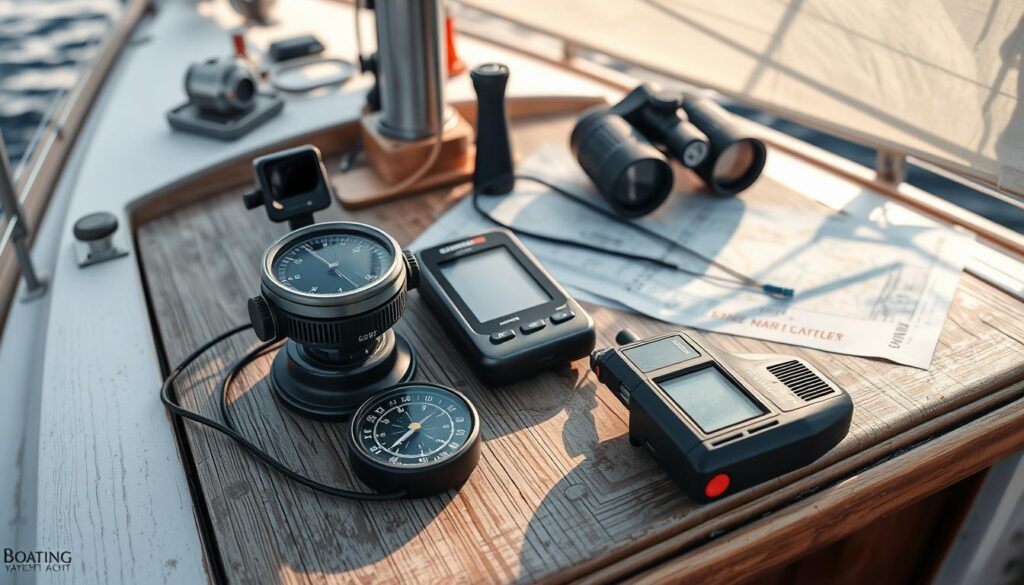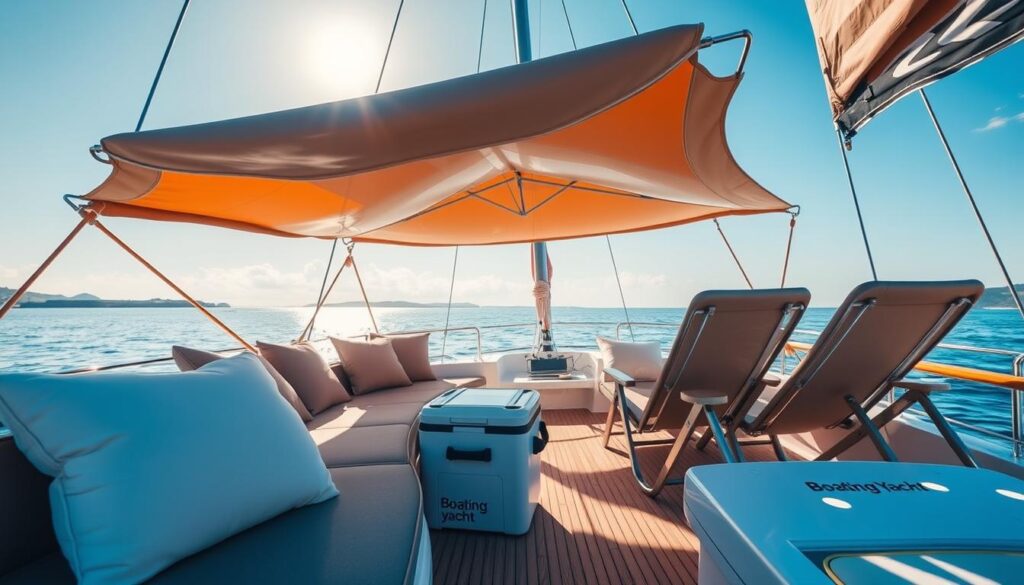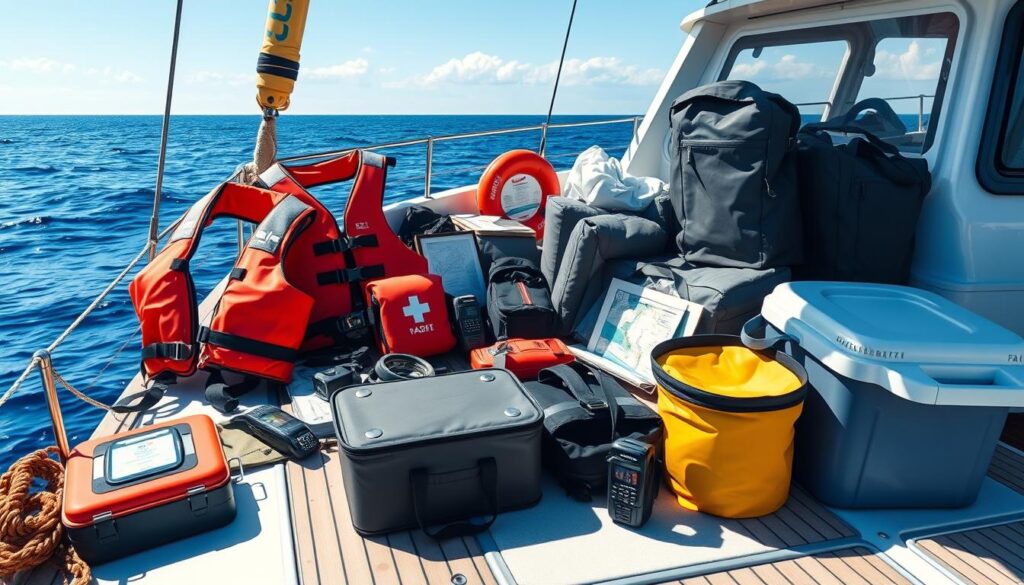Are you prepared for your next cruising trip? The open waters are exciting, but you need the proper boat accessories. Safety and navigation equipment are key to a first-rate experience.
Boat Outfitters lists thirteen essential sailing accessories. Safety is paramount, so everyone wishes the U.S. to wear a Coast Guard-accepted life jacket. Also, bring a marine first resource kit and a Personal Locator Beacon (PLB) for emergencies.
Navigation and communication are also vital. A GPS chartplotter enables you to plan routes and track your function. Marine binoculars are excellent for recognizing landmarks and vessels. A marine VHF radio keeps you in touch with others.
For consolation, don’t forget dry luggage to keep gear dry, cooler add-ons for foods and drinks, and sun chargers for devices. Fenders, guy overboard devices (MOBs), and marine fire extinguishers guard your boat and group.
Table of Contents
Key Takeaways
Essential tips for a safe and enjoyable boating experience.
Safety First
Life jackets, marine first aid kits, and PLBs
Navigation Tools
GPS chartplotters and marine binoculars
Stay Connected
Marine VHF radio
Enhance Comfort
Dry bags, cooler accessories, and solar chargers
Protect Your Boat
Fenders, MOBs, and marine fire extinguishers
Safety First: Must-Have Boat Accessories
When you cross boating, safety is vital. Having the proper boat safety device is critical. It maintains you and your friends secure and follows the regulations. Let’s communicate approximately three should-haves: existence jackets, marine first aid kits, and private locator beacons.
Life Jackets: Your First Line of Defense
Let’s start with the absolute essential: life jackets. When you’re out on the water, life jackets are your most basic yet vital defense. Think of them as the seatbelt of boating. They’re mandatory for good reason – they save lives. The U.S. Coast Guard requires that each person on board has a properly fitted, Coast Guard-approved life jacket, and they recommend that kids under 12 wear them at all times while the boat’s moving.
Now, a life jacket isn’t a “one size fits all” kind of thing. It needs to fit well to be effective, so check that each jacket is the right size for each person on board. Today’s life jackets come in comfortable, easy-to-wear styles – from inflatable models that stay compact until they’re needed to traditional foam ones with extra features. And remember to keep an extra throwable one onboard, just in case.
Pro Tip: Look for life jackets with added features like reflective strips, whistles, or even small storage pockets. These features can make a big difference, especially if you find yourself in low-light or emergency situations.
Marine First Aid Kit: Preparing for Emergencies
Boating takes you out of your usual surroundings, so a marine first aid kit is essential. On the water, even small scrapes and bumps can feel more serious when you’re far from shore. These kits are specially designed with waterproof bandages, seasickness remedies, and tools for handling everything from cuts to stings.
You don’t need a medical degree to use a first aid kit, but it helps to know what’s inside and how to use it. A good marine first aid kit will include items like bandages, antiseptic wipes, gauze, adhesive tape, and some basic medications. It’s also wise to carry a first aid manual or quick reference guide, especially one that covers marine-specific situations – these guides can be a lifesaver when time is of the essence.
Tip: Make a habit of checking your kit regularly. Replace anything that’s expired or used up, and refresh your memory on what’s inside. A well-stocked kit is reassuring to have, even if you never need it.
Personal Locator Beacon (PLB): A Lifesaving Device
A Personal Locator Beacon, or PLB, is small but mighty. It’s one of those items you hope you’ll never have to use, but you’ll be glad to have it if you ever do. In an emergency, activating your PLB sends out your location to rescue teams, even if you’re miles offshore and out of cell range. It’s especially crucial for those heading into remote waters, where help might not be close by.
Here’s how it works: when you activate your PLB, it sends a signal to emergency services with your exact coordinates, cutting down response time and ensuring rescuers can reach you quickly. Before you go, make sure your PLB is registered and familiarize yourself with how to activate it. Practicing in a safe environment helps you feel confident that you know what to do if the unexpected happens.
Example Scenario: Picture a sudden storm rolling in, visibility dropping, and you’re far from shore. With a PLB, you can send an emergency alert and give rescuers your exact location – a huge advantage when minutes count.
Having those protection objects for your boat makes you equipped for whatever. Always place safety first and follow the Terms of Service from your providers. In this manner, you may have a safe and amusing time on the water.
Navigation and Communication Essentials

Going on a sailing experience? You’ll need the right gear for secure and fun cruising. These tools assist you in finding your way and interacting with others. Today’s marine tech offers many ways to stay conscious and make clever alternatives.
GPS Chart plotter: Your Guide on the Water
A GPS chartplotter is a boater’s best friend. Think of it as your high-tech map and guide that gives you real-time information on your location, helping you plan routes, avoid hazards, and track your journey. With a chartplotter, you can set waypoints to mark your favorite fishing spots, safe harbors, or scenic spots you want to revisit.
When choosing a chartplotter, consider screen size and resolution. A clear display makes it easier to read in bright sunlight or during bumpy rides. Look for models that offer intuitive, touchscreen interfaces for easy navigation, and check compatibility with any other marine electronics you have, like depth sounders or radar.
Pro Tip: If you’re new to using chart plotters, practice using the device in a familiar area before heading out on an unfamiliar route. You’ll quickly get the hang of setting waypoints, following routes, and understanding how to read the digital chart – making it a reliable guide when you’re out on the open water.
When selecting a GPS, consider screen length, decision, and compatibility. Brands like Garmin, Raymarine, and Simrad have alternatives for all budgets. Dockwa’s blog has suggestions on choosing the excellent GPS for you.
Marine Binoculars: Enhancing Your Vision
A marine VHF radio is an essential tool for any boater. More than just a way to chat with other boats, a VHF radio is your primary line of communication with marinas, harbor masters, and, in emergencies, rescue services. Unlike cell phones, which can lose signal quickly on the water, a VHF radio gives you reliable coverage and quick access to emergency channels.
VHF radios come with various features – waterproofing, long battery life, and Digital Selective Calling (DSC), which lets you send distress signals with your location. Having DSC capability on your radio can be a lifesaver in emergencies, as it automatically transmits your location to rescue authorities. Many radios also have a weather alert feature that updates you on incoming storms or hazardous conditions.
Pro Tip: Before heading out, do a quick radio check by contacting a local marina or using a designated radio check channel. This ensures your radio is working properly and that you’re familiar with switching channels and initiating calls – skills that can make all the difference if you need to communicate in a hurry.
Marine VHF Radio: Staying Connected
A marine VHF radio is critical. It lets you speak to others and receive climate updates, and it’s essential when the cell carrier is negative.
VHF radios are higher for emergencies than phones. Look for waterproofing, long battery life, and DSC capability. Brands like Standard Horizon, Icom, and Uniden are popular.
“A marine VHF radio is not just a convenience; it’s a necessity. It’s your lifeline to the outside world when you’re out on the water.”
In summary, good navigation and communication gear is crucial for sailors. These tools improve your awareness and safety. Choose durable, reliable, and compatible gear for the best sailing experience.
Additional Tips for Effective Navigation and Communication
Have a Backup: Portable GPS and Radio
Technology is fantastic, but it’s always wise to carry a backup, especially on the water. A handheld GPS device or a compass can be invaluable if your main chartplotter malfunctions. Similarly, a handheld VHF radio with a charged battery can serve as a backup if your main radio loses power. These compact, portable options are affordable and provide peace of mind in case of unexpected issues.
Know Your Channels and Protocols
Understanding VHF radio channels and protocols can be just as important as having the radio itself. For instance, Channel 16 is the hailing and distress channel monitored by the Coast Guard and should only be used for emergencies or calling other vessels. Once you’ve established contact, switch to a different working channel to free up Channel 16 for emergencies. Familiarizing yourself with basic radio etiquette will make your communications clearer and more efficient.
Carry Paper Charts as a Backup
Even with the latest GPS technology, keeping a set of paper charts onboard is always a good idea. In the rare case that your electronics fail, paper charts provide a reliable backup, allowing you to navigate using traditional methods. Plotting your course on a paper chart also helps you stay aware of your location relative to hazards, landmarks, and other key points.
Example: Imagine you’re on a longer trip and lose GPS signal in foggy conditions. Having a paper chart lets you plot your approximate location, helping you navigate safely until visibility improves or signal returns.
Weather and Tide Tracking Apps
While these may not be “equipment” per se, weather and tide tracking apps on your smartphone can be incredibly helpful for real-time updates. Many boating apps provide local weather, tidal patterns, wave conditions, and even nearby hazards. You can use these tools to plan your day around safe windows and avoid getting caught in unpredictable weather.
Pro Tip: Download apps that work offline or store data temporarily, in case you lose cell signal. Apps like Navionics and NOAA Weather Radar provide offline access to saved data, ensuring you can still access critical information even without reception.
Comfort and Convenience boat accessories

Having the right boat comfort accessories makes a big difference on the water. They keep your gear dry and ensure you have fresh food and drinks. These items make your boating experience better.
Dry Bags: Keeping Your Gear Safe and Dry
Dry bags are essential for boaters who want to keep things safe and dry. Made from strong materials like nylon or vinyl, they seal tight to keep water out. They’re great for storing clothes, electronics, or important papers.
Cooler Accessories: Fresh Food and Drinks on the Go
Enhance your boating trip with the right cooler accessories and choose the ideal cooler size for your journey.
Essential Cooler Accessories:
- Ice packs: Keep your food cold
- Cooler dividers: Organize your food and drinks
- Cooler lights: See inside your cooler at night
- Cooler cushions: Use your cooler as a seat
| Cooler Size | Capacity (Cans) | Ideal Trip Length |
|---|---|---|
| 20-30 quarts | 24-36 | Day trips |
| 45-60 quarts | 54-72 | Weekend getaways |
| 75+ quarts | 90+ | Extended trips |
Solar Chargers: Harnessing the Power of the Sun
Staying connected on the water is important for safety and convenience. Solar chargers are a green way to keep your devices charged. They use the sun’s energy to power up phones, tablets, and GPS, so you’re always connected.
“Investing in good boat comfort accessories makes your boating better. It also gives you peace of mind, knowing you’re ready for anything on the water.”
Protecting Your Investment
Keep your vessel safe and lasting longer with essential boat protection accessories. Fenders, MOB devices, and marine fire extinguishers are crucial for every boat owner.
Fenders
Safeguarding Your Boat
- Protect from damage while docking
- Absorbs shock, prevents scratches
- Choose durable, easy-to-use fenders
MOB Device
Preparing for the Unexpected
- Sends alerts and GPS coordinates
- Compact, easy to use, reliable
- Consider battery life and range
Marine Fire Extinguisher
Fighting Fires on the Water
- Essential for boat and passenger safety
- Use marine-rated extinguishers
- Regular checks and maintenance
Investing in these accessories helps protect your boat and ensures a safer journey on the water.

